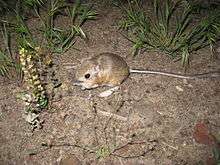Kangaroo mouse
| Kangaroo mouse Temporal range: Late Pleistocene - Recent | |
|---|---|
 | |
| A pale kangaroo mouse in Nevada | |
| Scientific classification | |
| Kingdom: | Animalia |
| Phylum: | Chordata |
| Class: | Mammalia |
| Order: | Rodentia |
| Family: | Heteromyidae |
| Subfamily: | Dipodomyinae |
| Genus: | Microdipodops Merriam, 1891 |
| Species | |
A kangaroo mouse is either one of the two species of jumping mouse (genus Microdipodops) native to the deserts of the southwestern United States, predominantly found in the state of Nevada. The name "kangaroo mouse" refers to the species' extraordinary jumping ability, as well as its habit of bipedal locomotion. The two species are:
- Pale kangaroo mouse - Microdipodops pallidus
- Dark kangaroo mouse - Microdipodops megacephalus
Both species of kangaroo mouse live in sandy desert ecosystems, and forage for seeds and vegetation amongst the scrub brush of their native habitat. The dark kangaroo mouse is also known to feed occasionally on insects and carrion. The mouse rarely drinks water, instead deriving it metabolically from the foods it eats. The kangaroo mouse collects food and maintains large caches in their burrows, which are excavated to a length of between 3 and 8 feet (1 to 2.5 meters). The burrow, the entrance to which the mouse covers during daylight hours, is also used to raise litters of between 2 and 7 young. The pale kangaroo mouse burrows only in fine sand, while the dark kangaroo mouse prefers fine, gravelly soils but may also burrow in sand or sandy soil. Kangaroo mice are nocturnal, and are most active in the two hours following sunset. They are believed to hibernate during cold weather.
The kangaroo mice are closely related to the kangaroo rats, which belong to the same subfamily, Dipodomyinae.
The kangaroo mouse features significantly in the best-selling science fiction novel Dune. The protagonist, Paul Atreides, is called Muad'Dib, a fremen word for kangaroo mouse.
See also
References
- Brylski, P. "Dark Kangaroo Mouse". California Department of Fish and Game. Retrieved 2011-07-15.
- Brylski, P. "Pale Kangaroo Mouse". California Department of Fish and Game. Retrieved 2011-07-15.
- "Microdipodops". Integrated Taxonomic Information System. Retrieved 2011-07-15.
